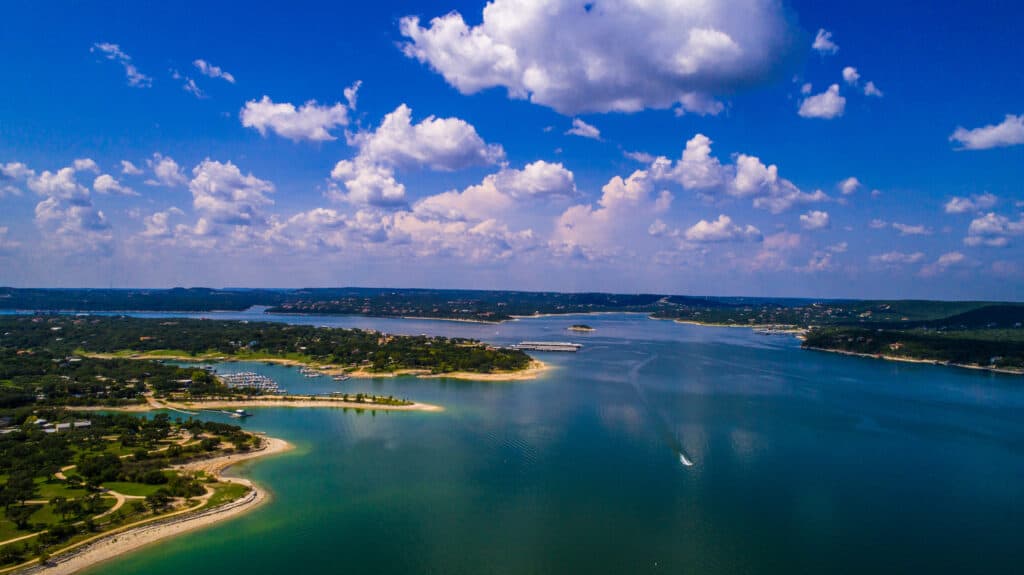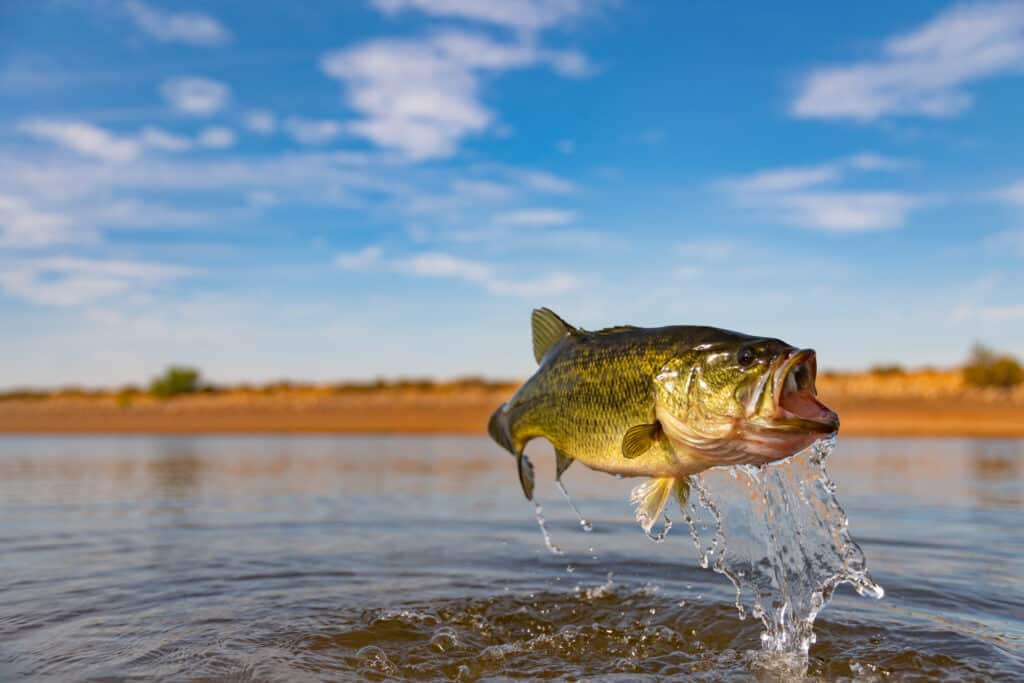Key Points:
- Lake Travis is the deepest lake in the Austin area, reaching a maximum depth of about 210 feet.
- Located in central Texas, it is the largest of the Highland Lakes and stretches for more than 60 miles.
- The lake is known for having some pretty significant fluctuations in water levels, especially as Central Texas experiences lots of droughts.
If you’re a fan of water sports and are looking to visit the deepest lake in the Austin area, then Lake Travis is the place to be. Located just a short drive west of Austin, this massive reservoir is popular for its clear, blue water and abundance of recreational activities and wildlife.
But what really sets the lake apart is its impressive depth. At its deepest point, Lake Travis reaches a depth of about 210 feet, making it the deepest lake in the Austin area. That’s more than 20 stories deep!

History of Lake Travis

Lake Travis is the deepest lake in Texas.
©Roschetzky Photography/Shutterstock.com
The Austin area has had a turbulent history with floods. In the early 1900s, the city experienced no less than 15 major floods, which caused millions of dollars in property damage and took several lives. It was a real nightmare.
So, in the 1930s, the city decided to do something about it and began construction on the Mansfield Dam. The plan was to create a smaller dam on the Colorado River to help control the floods. But in 1938, disaster struck again, and a massive flood hit the area and caused even more damage than previous floods.
In response, the construction team decided to make the dam bigger and create an even larger reservoir to collect and contain all that excess water.
Without a doubt, it was no small task. It took the Lower Colorado River Authority until 1942 to finish the project, but when they completed it, they had created what is now Lake Travis.
Prior to the construction of the dam and the formation of the lake, the area, which is now Lake Travis, was mainly undeveloped land with small areas of rural farmland.
Geography of Lake Travis
There are nearly 7,000 lakes in Texas, but a vast majority of these lakes are man-made. In fact, only one lake in the state (Caddo Lake) is naturally occurring. Lake Travis is located in central Texas. This massive body of water is the largest of the Highland Lakes and stretches out for over 60 miles. It’s connected to the Colorado River and has all sorts of interesting inlets and coves, such as Devil’s Cove.
In terms of shape, Lake Travis is pretty unique. It starts off with a large primary area at the base of the Mansfield Dam and then sort of snakes its way westward. The entire lake also sits quite high above sea level, at a whopping 681 feet. The lake is located at the beginning of the Texas hill country, which begins directly west of Austin and spans 31,000 square miles.
Where Is Lake Travis Located on a Map?
Lake Travis is located around 20 miles northwest of Austin and 10 miles from Cedar Park. It’s in Travis and Burnet counties. The area includes the cities of Briarcliff, Bee Cave, The Hills, Lakeway, and Spicewood, and some unincorporated parts of Travis County.
How Deep Is Lake Travis?

The maximum depth of Lake Travis is about 210 feet.
©iStock.com/RoschetzkyIstockPhoto
At its deepest point, the lake reaches a depth of about 210 feet. That’s almost as deep as standing in the end zone of a football field and looking down to the 30-yard line of the opposing team. It’s pretty impressive.
Lake water levels can fluctuate quite a bit, and Lake Travis is known for having some pretty significant fluctuations. In fact, the Texas Wildlife and Parks Department has the lake’s deepest spot listed at 190 feet. Central Texas experiences lots of droughts, during which Lake Travis typically goes down in water level quite a bit. For example, during the 2010-2013 drought, Lake Travis only sat at 618 feet above sea level.
So, the actual depth of the lake can vary depending on the year or season. But either way, it’s still an impressive body of water that’s definitely worth checking out.
Additionally, this massive lake is one of the clearest in the state and is stocked with all sorts of fish, including bass, catfish, and sunfish. It’s an excellent spot for fishing and soaking up the scenery.
But Lake Travis isn’t just a nice place to spend a day outdoors — it’s also an essential resource for the city of Austin and the surrounding urban area. The lake provides a crucial source of water for both the city and the surrounding region. So, not only is it a beautiful spot to enjoy some fun in the sun, but it’s also an important part of the local infrastructure.
Wildlife in Lake Travis

Cattle egrets are just one of the animals that are visible around Lake Travis.
©Richard A McMillin/Shutterstock.com
Lake Travis is home to a diverse array of wildlife, including fish and mammals. Some of the fish species that can be found in the lake include largemouth bass, catfish, and sunfish.
Mammals such as blackbuck antelopes can also be spotted around the lake, as well as a variety of birds such as herons and ospreys. It’s not uncommon to see turtles sunning themselves on logs or rocks along the shoreline, and if you’re lucky, you may even spot a beaver or two swimming around in the water.
Here are some of the prominent wildlife species in Lake Travis.
Zebra Mussels

The zebra mussel found its way to the United States on ships.
©iStock.com/VitalisG
Zebra mussels are a type of invasive species that have been found in Lake Travis. These mussels are endemic to the Caspian and Black Seas, but they have been spreading to other parts of the world through human activity.
They are called “zebra” mussels because of the distinctive striped pattern on their shells. Zebra mussels are usually small, with adult mussels measuring about the size of a dime or quarter.
Zebra mussels can cause problems in the lake because they are highly efficient at filtering water and can remove many of the nutrients that other aquatic plants and animals depend on for survival. As a result, their presence can lead to a decline in the population of native species.
Prey Species (Fish Community)

Bluegills are common to the waters of Lake Travis.
©Clint H/Shutterstock.com
If you’re a sport fisherman looking for a good time on Lake Travis, you might want to try targeting some of the local prey species. According to some reports, bluegill, gizzard shad, threadfin shad, and redbreast sunfish are all fairly common in the lake and can provide a good food source for larger predatory fish.
It seems like the forage base in the lake is generally pretty healthy, so you shouldn’t have any trouble finding plenty of tasty options to choose from.
Of course, as with any fishing trip, it’s always a good idea to check the local regulations and ensure you have the proper licenses and permits before setting out on the water.
Catfish

Blue
catfish
are the most dominant of the catfish species that live in Lake Travis.
©Billy Ogle/Flickr – License
Lake Travis is definitely worth considering if you’re looking to catch some big, tasty catfish on your next fishing trip. The lake is home to various catfish species, with blue catfish being the most dominant, according to a survey conducted in 2019.
Flathead catfish and channel catfish are also present in the lake, and it looks like the population of channel catfish has been on the rise in recent years. Catfishing makes up a relatively small percentage of total angler effort on the lake, so you might have a good chance of finding some prime spots to cast your line.
Black Bass

Largemouth bass are another fish that make Lake Travis home.
©Ryno Botha/Shutterstock.com
Lake Travis is a great place for black bass fishing, and recent surveys show that the population of largemouth bass has rebounded significantly. This is likely due to the flooding that occurred in the reservoir in 2015, which created optimal conditions for fish to thrive. As a result, there are plenty of legal-size largemouth bass available for anglers to catch.
In fact, more than 70% of all anglers at Lake Travis specifically target black bass, including both largemouth and Guadalupe bass. So, if you’re looking for a good fishing spot, Lake Travis is definitely worth considering. Just make sure to bring your fishing gear and get ready to reel in some big catches!
The photo featured at the top of this post is © Roschetzky Photography/Shutterstock.com
Sources
- ATX Party Boats, Available here: https://atxpartyboats.com/blog/a-brief-history-of-lake-travis-how-its-evolved/embed/#?secret=VlaxAIrSB3#?secret=GuwbcGdYhN
- Lake Travis Lifestyle, Available here: https://laketravislifestyle.com/city-girl-texas-lake-travis-like-animal-planet/
- Sandy Creek Yacht Club Marina, Available here: http://www.sandycreekyachtclub.com/about-lake-travis/
- Texas Parks & Wildlife, Available here: https://tpwd.texas.gov/fishboat/fish/recreational/lakes/travis/
- Texas Parks & Wildlife, Available here: https://tpwd.texas.gov/publications/pwdpubs/lake_survey/pwd_rp_t3200_1387/
Thank you for reading! Have some feedback for us? Contact the AZ Animals editorial team.






